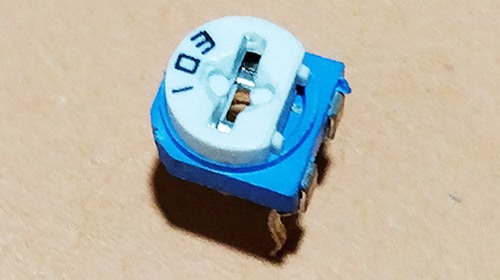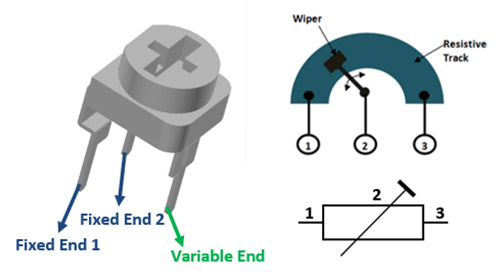Preset Potentiometer (Trimpot)
A Trimpot is another type of potentiometer that comes in small package. It has three leads and can be easily mounted on breadboard or perf board for quick prototyping. The value of the pot can changed by varying the knob on top of it.
Pin Configuration
|
Pin No. |
Pin Name |
Description |
|
1 |
Fixed End 1 |
This end is connected to one end of the resistive track |
|
2 |
Variable End |
This end is connected to the wiper, to provide variable voltage |
|
3 |
Fixed End 1 |
This end is connected to another end of the resistive track |
Features
- Type: Preset Potentiometer – Trimpot
- Available in standard or carbon film type
- Available in different resistance values like 500Ω, 1K, 2K, 5K, 10K, 20K, 50K, 100K, 200K,1M.
- Maximum operating Voltage: 50V DC
- Rotational Life: 20 cycles
Note: Complete Technical Details can be found at the trimpot datasheet given at the end of this page.
Alternative Variable Resistors
Thumbwheel Potentiometer, Potentiometer, Trimmer
Selecting a Potentiometer
Potentiometers also known as POT, are nothing but variable resistors. They can provide a variable resistance by simply varying the knob on top of its head. It can be classified based on two main parameters. One is their Resistance (R-ohms) itself and the other is its Power (P-Watts) rating.
The value or resistance decides how much opposition it provides to the flow of current. The greater the resistor value the smaller the current will flow. Some standard values for a potentiometer are 500Ω, 1K, 2K, 5K, 10K, 22K, 47K, 50K, 100K, 220K, 470K, 500K, 1M.
Resistors are also classified based on how much current it can allow; this is called Power (wattage) rating. The higher the power rating the bigger the resistor gets and it can also more current. For potentiometers the power rating is 0.3W and hence can be used only for low current circuits.
Difference between a Preset Pot and Normal Potentiometer
Preset pots and potentiometer almost work like the same, but they both have totally different applications. The preset pot comes in small package and can be mounted on the PCB or perf board. Due to its small size the power rating is also less than knob type potentiometers.
These potentiometers are not meant to be controlled by users. They are used by engineers to fine tune or calibrate the design after the fabrication is complete. Once calibrated to right value, these pots will no longer be used to vary the resistance and acts like normal resistors. This is why they have low rotation life of only turns.
Identifying values of Preset Potentiometer
The value of a preset potentiometer will be written on top of it in three digits, something similar to ceramic capacitors. The first two digits is the actual value and the 3rd digit has to be taken to the power of ten. For example in digits 202, the first two digits 20 is taken as such and the 3rd digit is taken to the power of 10. So it becomes 20×102 which becomes 2000 which is nothing but 2K potentiometer. The below table lists all the possible values.

How to Use a Potentiometer
As far as we know resistors should always have two terminals but, why a potentiometer has three terminals and how to we use these terminals. It is very easy to understand the purpose of these terminals by looking at the diagram below.

The diagram shows the parts present inside a potentiometer. We have a resistive track whose complete resistance will be equal to the rated resistance value of the POT.
As the symbol suggests a potentiometer is nothing but a resistor with one variable end. Let us assume a 10k potentiometer, here if we measure the resistance between terminal 1 and terminal 3 we will get a value of 10k because both the terminals are fixed ends of the potentiometer. Now, let us place the wiper exactly at 25% from terminal 1 as shown above and if we measure the resistance between 1 and 2 we will get 25% of 10k which is 2.5K and measuring across terminal 2 and 3 will give a resistance of 7.5K.
So the terminals 1 and 2 or terminals 2 and 3 can be used to obtain the variable resistance and the knob can be used to vary the resistance and set the required value.
Applications
- Voltage and Current Control Circuits
- Used as volume control knobs in radios
- Tuning or controlling circuits
- Analog input control knobs
2D-Model/Dimensions of Preset Potentiometer (RM-065)
-2d-model.jpg)






